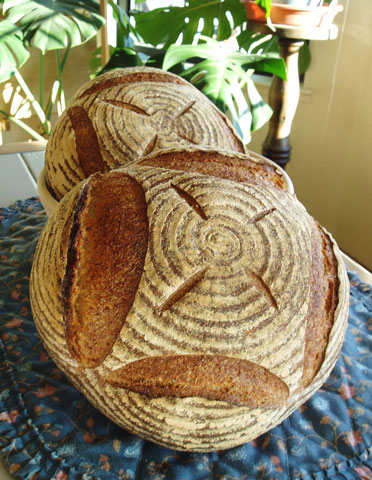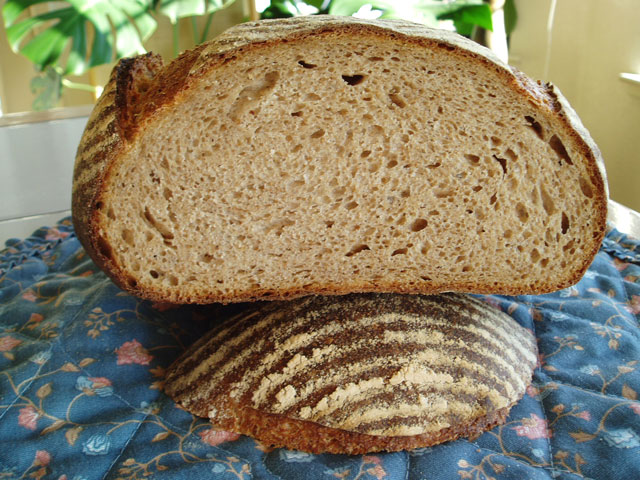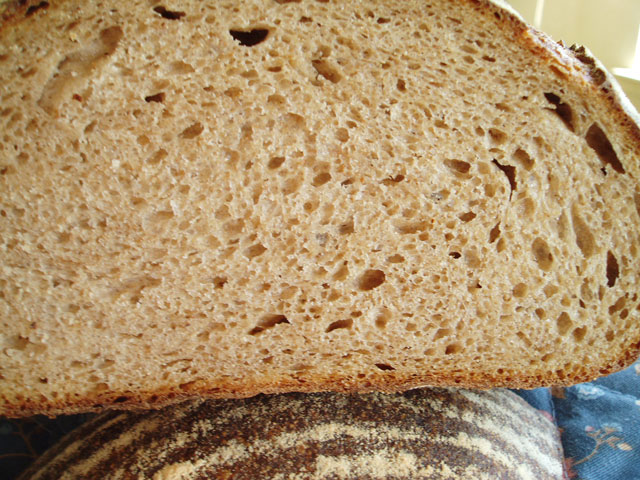
Double Levain 50% Whole Wheat and Rye
I have been reading with interest the postings by Andy (ananda) about his work with double levain breads. Until now I had not experimented with them, but I had a fully refreshed rye sour at hand. I have already baked a solid brick of a Russian Black bread with that sour, and whilst licking my wounds I have been looking for something a little less difficult to exercise my sours with. I'm not sure if double levain falls in that category or not, but at least it is not a 100% rye bread.
I read and reread Andy's posts, and finally decided to just plunge in and give it a try. After all, that's half the fun of baking, for me anyway. I composed a formula based on my existing rye (80% hydration based on the formula from Inside the Jewish Bakery) and wheat (66% hydration) sours, targeting a total of 30% prefermented flour in the batch, and dividing the preferment as 1/3 rye and 2/3 wheat sours. Both sours are being actively fed twice daily. I also wanted to include a good portion of whole wheat flour from my home mill, but I was not willing to go 100%, so I ended up with some Portland Mills Morebread (All Purpose) flour in the mix as well.
The overall formula for two 750 gm boulles broke down like this:
Grams
Wheat Levain: 287
Rye Sour 162
PMI AP Flour 266
BRM Dark Rye Flour 86
Fresh Whole Wheat flour 265
Salt (1.5%) 13
Water (70% Hydration) 430
I hand mixed the batch enirely, beginning with the sours and water in a large bowl, then adding the remaining flours and mixing to a shaggy mass. I rested the dough for 30 minutes, then added the salt and mixed it in thoroughly, along with another 15-20 grams of water because the dough was too dry. My home-milled wheat flour is very thirsty and always requires a little extra water.
I bulk fermented the dough in a clear bucket for what ended up being 3 ½ hours, doing stretch and folds on the counter at 1,2, and 2 ½ hours. It ended up stretching out to 3 ½ hours in bulk because dinner was ready just at the time when I should have been dividing. We ate, I did the dishes, then I divided and shaped the dough into two rounds, and placed them in floured cane bannetons to proof. Because I planned to bake them consecutively in my La Cloche clay baker, I moved one loaf to a cool place after about 45 minutes of proofing. The other remained where it was warmer. The difference was not enough, and the second loaf mildly over proofed.
As planned, I baked these consecutively in my La Cloche. The La Cloche (top and bottom both) was preheated to 535F on preheated tiles on the lower rack of the oven. The bread was loaded, and after 10 minutes the temperature was turned down to 485F. At 15 minutes into the bake I removed the La Cloche lid from the oven and completed the bake at 485F in 15 to18 minutes for each loaf. Between loaves I returned the La Cloche top to the oven while the preheat temperature of 535F recovered.
Here are the two boulles.

The crumb:

And closer:

Overall I am pleased with this bake. It was a successful experiment. The loaves baked up very nicely, with a nice bold crust, which I prefer. The crumb is, for a 50% whole grain and rye bread, pretty good, and perhaps even very good. It is certainly not a brick like a certain Russian Black Bread of recent experience. The thing which surprised me is the flavor. The flavor is not excellent, but I would call it very good. The rye flavor is fairly strong, but the whole wheat is somewhat muted, and certainly overshadowed by the sour tang.
I would rate the flavor higher but that it came out too sour for our taste, and I must read more to determine why that happened. I was unprepared for this outcome because I did not retard the dough in any way, but rather took it directly from the main build through bulk fermentation, shaping, proofing and into the oven. The bulk fermentation time was a little longer than planned but not exageratedly so. Still, the sour flavor is as strong as if I had retarded the dough overnight in a cool spot. I conclude on a preliminary basis then that the extra sour flavor comes from the acidity of the rye sour, or perhaps the bulk fermentation time should have been much shorter than 3 hours because of the whole grain hyperactivity. After more reading I will try this again and try to tone down the sour a notch or two. I'd like to be able to taste the bread itself more than this bake allows. It will be fun learning to manage and bake with double levains.
Thank you Andy (ananda) for the inspiration, and especially for your great descriptions of your double levain bakes to guide me.
Thanks for stopping by
OldWoodenSpoon


Comments
Hi OWS,
They are really lovely looking loaves, and I am very happy to find you took inspiration from my posts.
Your deductions are quite correct.
Try reducing your pre-fermented flour to 25% [17% wheat and 8% rye flour].
Yes, reduce your BF time.
Additionally, you could replace some of the rye flour in your final formula with more of your freshly ground wheat?
Very best wishes to you
Andy
I appreciate your kind words, as well as the helpful tips. I'll give them a try next weekend, I hope. If the weather will permit firing up the WFO next weekend I will make a batch of this bread to bake in it. If not, then I'll warm up the kitchen oven instead.
OldWoodenSpoon
Hey Spoon! Great looking loaves... and the crumb! Excellent!
It made great toast at breakfast today! My wife likes it with creme cheese, but I had butter on mine. Maybe I'll try the creme cheese this afternoon for a snack.
OldWoodenSpoon
Those are real beauties, OWS, inside and out! Great, great stuff!
Marcus
Thanks for the compliments Marcus. I appreciate you taking the time.
OldWoodenSpoon
Hello OWS,
Admiring your beautiful loaves (the scoring and oven spring!) and the effort you put into making these
(the thought, the twice-daily-fed starters, the milling)!
:^) from breadsong
from a high achiever! Thank you breadsong!
OldWoodenSpoon
Terrific scoring and crumb. The very nice, symmetric bloom says, "perfect shaping and perfect proofing."
I'm with Andy, if you want less tang. You had a really high percentage pre-fermented dough.
Actually, this sounds like a bread I'd like. The things you don't like about it are things I do like.
David
I appreciate the compliment David. I will make the adjustments you and Andy suggest and bake this again soon. I often use such a high percentage of preferment because it helps move things along in my very cool house and kitchen. I will spend the extra time it might require as a result of lowering the preferment percentage willingly though if it tames the sour tang a few degrees.
OldWoodenSpoon
Hi OWS,
Lovely looking bread. The scoring really caught my eye. I quite often use to starters in my bread. I thought you must have a cold house to get away with that amount of bulk ferment using that 30% prefermented flour. It may also pay to use the starters a little earlier if using that amount in the final dough. If I am using a rye starter in conjunction with a wheat starter in say a campange style loaf I don't add any further rye flour to the dough ... ie. the total rye flour is used in the starter. I think this also helps keep the tang a little milder.
Superb oven sping in the la cloche.
Cheers,
Phil
I seem to use more preferment than many bakers consider advisable. I hear comments about it often, and in this case I'm sure they are probably right. It is the result of struggling to cope with our very cool house all fall and winter. We have, but do not usually use, central heat, so all those parts of the house not close to the wood stove are cool to cold much of the time.
Thanks for the additional tip on dealing with the rye sour in these double levain doughs. I have a lot to learn. As for the La Cloche, it is one of my favorite baking tools. When I can't fire up the WFO that is! I have always gotten good results with it, and I think that is at least partly due to my practice of preheating the entire baker, top and bottom, for every bake. Many report good results starting with the baker cold. Others preheat only the bottom. A few of us are crazy enough to preheat the lid too. I really think it is a major reason for the spring I get from baking in it. The extra heat immediately available pays of in just that way.
Thank you for taking time to comment.
OldWoodenSpoon
I have seen quite a few formulas with the prefermented flour up around the 25%-30%. My last bake was a wholemeal with 25% white flour prefermented. I am very careful though about the condition of the levain/starter when using this amount. I don't let it get too far gone so I am not introducing a large hit of acid into the final dough. The la cloche is a definitely something I would like to use one day.
Cheers,
Phil
Hi Phil,
Generally I agree with your thoughts about keeping the leaven fresh.
But I just wanted to add MY logic for using 2 leavens in the first place.
The rye is a genuine "sourdough", fermented through for 18 hours.
The wheat levain, on the other hand is a naturally fermenting dough just approaching its peak activity.
The idea is to create the ideal conditions for both wild yeast activity and bacterial fermentation.
Very best wishes
Andy
Hi Andy,
Your logic is spot on and I should have been more clear. I was talking about the wheat levain when I mentioned using a fresh starter.
So you are using the wheat leaven for ideal yeast and the rye for bacterial ... am I getting this right? When I have started using two starters I guess it was for similar reasons but maybe not as well thought out. I was using a larger a larger amount of fresh wheat levain for the leavening and a smaller amount of rye starter for flavour (also soaking as I mill the flour for the rye starter coarsely)
Cheers,
Phil
Hi Phil,
You probably are well aware of my passion for what Nico calls "the dark side"! ie. High Rye Breads.
Given I spent 10 years as a production baker making a range of traditional breads which included 2 different 100% Rye pastes [I don't like to call it dough!], it is understandable that I came to the conclusion that rye sourdough has a particular application in this context.
The acid is there to support the delicate pentosans as you enter the final stages of proof and the early part of the baking cycle. I take it you are only too aware of the gummy, collapsing and fatal consequences of failing to apply these principles. Additionally, at Village Bakery, we put a 7 day shelf life on the Rye sourdough breads, and they actually sat in out bakery a full day before being despatched. At such high moisture levels, using 85% hydration, the acid in the final loaf is an essential preservative, as it prevents harmful moulds and bacteria from being able to prosper in what would otherwise be an ideal environment.
Some people do not discriminate between different types of what might, generically, be labelled as sourdough bread. This is not a view I share. My rye sourdough is liquid, and it is fermented a full 18 hours before use. So if that is my sole leavener, then the bread might well tend to be labelled sourdough...although that depends on the amount then used in the final formula. For instance Rossisky may have 50% pre-fermented flour if using the 3 stage Auerman process, whereas I might go as low as 8-10% pre-fermented flour in the form of a rye sour when making Pain de Siegle de Thezac. My wheat levain is always taken to make the final dough when it is just peaking. In your case, living with the extreme summer temperatures you have [I am soo jealous!], I too would be taking the leaven sooner rather than later. I don't like to think of a Pain au Levain, or a Pain de Campagne, for example, as a "sourdough" bread. I appreciate others may not share this view.
All good wishes
Andy
Andy,
your comment is making me rethink my baking processes.
Thanks a lot for this push.
And OldWoodenSpoon,
Your breads look just perfect. As for the tang, I am with David on that issue.
Juergen
I appreciate the compliment. I know that many like their sour more sharp than I. This bake would suit all of you well I think.
I am also seeing Andy's point about shelf life with this bread in my own kitchen. I had some of this as toast this morning from the "bread bag" (brown paper grocery sack) on the kitchen counter, and it is holding up extremely well.
OldWoodenSpoon
The two or three too-sour bakes that I have had were all made with whole wheat flour; not a speck of rye in sight. Given that your flour is freshly milled, it may favor the LAB more than you expect. As others have noted, a shorter bulk ferment or lower percentage of prefermented flour should address the issue.
Debra Wink did a fairly in-depth explanation of the biology and chemistry that lead to acid production, much of which went over my head. The part that did stick with me is that the higher the ash content of a flour (and whole grain is as high as you can get), the greater the acid output by the LAB during fermentation. Whether it favors lactic or acetic acid, I don't recall.
Whether or not you enjoy the flavor, those are beautiful loaves.
Paul
for the kind words too. I have had some other too-sour bakes with my home-milled whole wheat flour, but only very rarely to this degree. Really only to this degree when a long, cool bulk fermentation was involved. I bake what I refer to as "my sourdough" with 5 to 15 percent home-milled whole wheat and 5% dark rye a couple of times a month. Those loaves are just not this sour. They also do not use a rye sour, but they do use this same wheat starter, or it's 100% hydration sibling of otherwise same lineage. In this particular case I really do think the rye sour is a significant factor, and I will test the assertion about too much prefermented flour (and perhaps too much rye flour overall) to see what difference it makes.
Thanks for the reminder about Debra Wink. She should already have been on my list to look to for additional reading. I also wish I owned a copy of Hamelman's "Bread", but even my library does not have it. I believe he also covers some of these areas in fair detail. I'm hopeful Santa Claus will resolve this eggregious deficiency in my meagre book collection. Till then I'll rely on other resources. I'll never read it all, let alone understand it all, anyway.
OldWoodenSpoon
on fermentation and acid production. Gotta love it when memory and the Search function work together.
Paul
Well, I read through that late last night, and then I slept very well! I shall give it another go in a day or two, but I found Debra's comments about the impact of the temperatures maintained in developing the sours especially interesting indeed. I kept the elaborations of both the rye and wheat starters for this bake in my makeshift proofing box (a big Sony CRT monitor box with an electric frypan full of water in the bottom and a shelf in the middle) set at about 80F. I was trying to get them up to maximum actity levels. If I understood Debra correctly (not very likely), I thereby provided conditions strongly oriented to maximizing acidity in both cultures. No wonder my bread was sour!
I did not understand enough of the material on one read to take any actions, but it sure has gotten me thinking. I wanted to thank you again for the reminder, and for hunting the link down for me. It is something I certainly need to learn more about, and not just for double levain doughs.
I also wanted to ask you a question though: got any aspirin? I've got a headache that won't quit!
Thanks again Paul
OldWoodenSpoon
It is very useful information - if you can absorb it. An engineering education didn't prepare me well for something like this, I'm afraid.
Here's hoping your headache fades quickly.
Paul
Lovely looking bread, inside out, WS! Really successful after the brick you had, and spot on , i'd say. i agree with Andy regarding the preferment, and as Paul said, fresh flour does increase acidity.
for the compliment! The brick was a genuine article, so this bake made me feel much better. I plan to test the outcome of the reduced preferment percentage soon, and I will surely report it back here.
Thanks again
OldWoodenSpoon